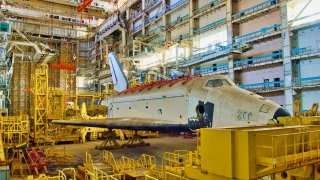The Soviet's Buran Space Shuttle Was a True One-Hit Wonder
Its lone mission was uncrewed. The Buran relied on an automated launch sequence, rode on an Energia rocket, and performed an automated, horizontal landing on a runway. The entire mission lasted 208 minutes, and the Buran would never fly again.
When people think of a space shuttle they think of the American version – the space shuttle, or orbiter, a reusable, winged spacecraft that rode to orbit on a rocket but landed back on Earth like an aircraft on a runway.
But the Americans weren’t the only nation to develop a reusable orbiter. The Soviets made one too, and it was known as the Buran.
One Hit Wonder
The Buran did fly in space – just once, in November 1988, not long before the Soviet Union collapsed. Its lone mission was uncrewed. The Buran relied on an automated launch sequence, rode on an Energia rocket, and performed an automated, horizontal landing on a runway. The entire mission lasted 208 minutes, and the Buran would never fly again.
While a Soviet crew never traveled aboard the Buran, the vessel did make history as the first spaceplane to ever perform an automated, uncrewed flight. The Buran was supposed to have a second flight, with a longer duration of two to three weeks. But when the Soviet Union collapsed, the Buran program was put on hold, and in 1993, the Buran’s second flight was formally cancelled.
Building the Buran
The American space shuttle is commonly regarded as the most sophisticated man-made machine ever built. The Buran was similarly complicated, if not as high-quality. The vessel was built around the airframe, with all other components attached to the frame’s base. Just like the American shuttle, tiny carbon heat-shielding tiles were glued to the underside of the Buran. In all, 38,000 tiles were used to coat the Buran, arranged with small gaps between them to allow for thermal expansion. Within the gaps, the builders inserted quartz fiber, rope, alkaline elements, inserts, and brush seals.
The Buran copied another of the American shuttle’s most recognizable features, the robotic manipulator arm. The Buran’s version, known as the Onboard Manipulator System, was built to assist with payload operations. However, the system was not installed before the Buran’s lone flight, and it never served in space.
For propulsion on final approach, the Buran was designed to incorporate two Saturn AL-31 jet engines situated on either side of the shuttle’s tailfin. However, for the Buran’s only flight, the engines were not installed. Instead, the automatic landing system landed without correction from engines. Had the engines been installed, they likely would have had measured 39,000 pounds of thrust. For fuel, the engines would have relied upon the booster’s RD-170 liquid oxygen/kerosene engine and four RD-0120 liquid oxygen/liquid hydrogen engines attached to the shuttle’s central block.
In all, the Buran weighed around 62 tons, with a maximum payload of 30 tons. The shuttle measured 120 feet long with a 78-foot wingspan. The payload bay was 60 feet long with a 15-foot diameter.
Unfortunately, in 2002 the hangar storing the Buran collapsed, destroying the lone Soviet space shuttle.
About the Author: Harrison Kass
Harrison Kass is a defense and national security writer with over 1,000 total pieces on issues involving global affairs. An attorney, pilot, guitarist, and minor pro hockey player, Harrison joined the US Air Force as a Pilot Trainee but was medically discharged. Harrison holds a BA from Lake Forest College, a JD from the University of Oregon, and an MA from New York University. Harrison listens to Dokken.
Image: Shutterstock.com


